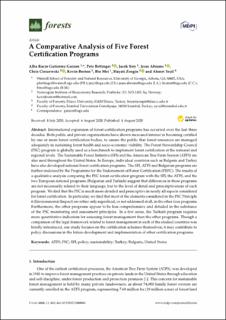| dc.description.abstract | International expansion of forest certification programs has occurred over the last three decades. Both public and private organizations have shown increased interest in becoming certified by one or more forest certification bodies, to assure the public that forest resources are managed adequately in sustaining forest health and socio-economic viability. The Forest Stewardship Council (FSC) program is globally used as a benchmark to implement forest certification at the national and regional levels. The Sustainable Forest Initiative (SFI) and the American Tree Farm System (ATFS) are also used throughout the United States. In Europe, individual countries such as Bulgaria and Turkey have also developed national forest certification programs. The SFI, ATFS and Bulgarian programs are further endorsed by the Programme for the Endorsement of Forest Certification (PEFC). The results of a qualitative analysis comparing the FSC forest certification program with the SFI, the ATFS, and the two European national programs (Bulgarian and Turkish) suggest that differences in these programs are not necessarily related to their language, but to the level of detail and prescriptiveness of each program. We find that the FSC is much more detailed and prescriptive in nearly all aspects considered for forest certification. In particular, we find that most of the elements considered in the FSC Principle 6 (Environmental Impact) are either only superficial, or not addressed at all, in the other four programs. Furthermore, the other programs appear to be less comprehensive and detailed in the substance of the FSC monitoring and assessment principles. In a few areas, the Turkish program requires more quantitative indicators for assessing forest management than the other programs. Though a comparison of the legal framework related to forest management in each of the studied countries was briefly introduced, our study focuses on the certification schemes themselves; it may contribute to policy discussions in the future development and implementation of other certification programs. | en_US |

